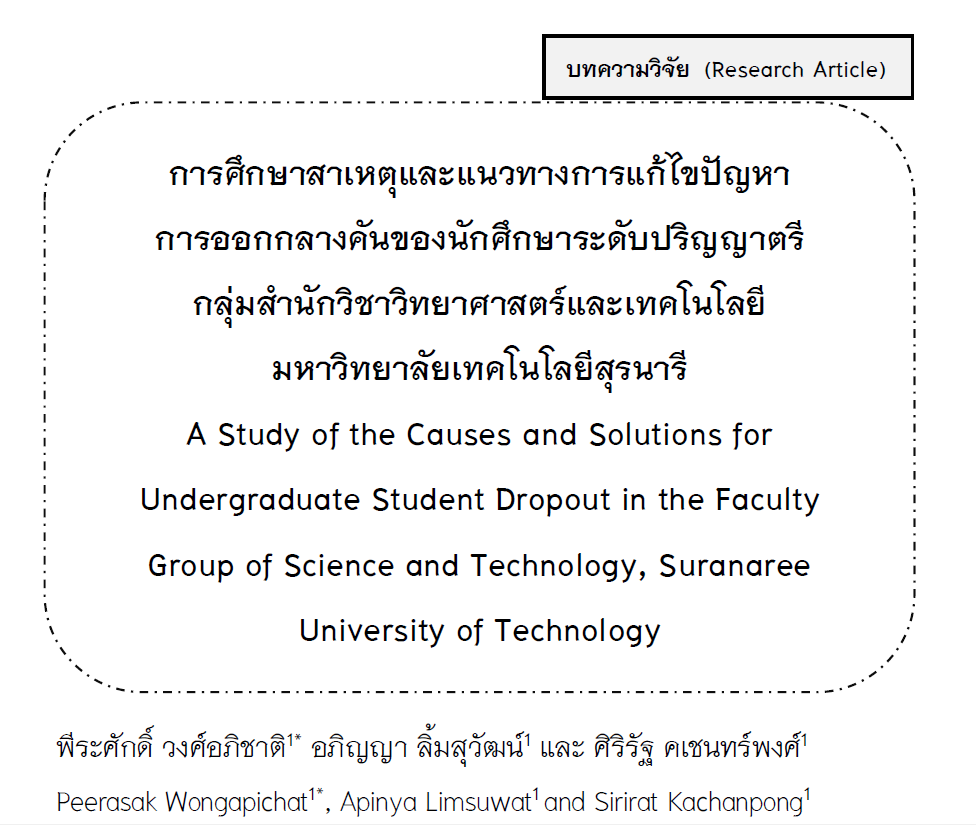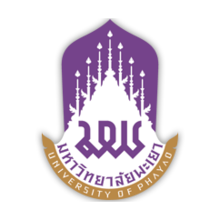การศึกษาสาเหตุและแนวทางการแก้ไขปัญหา การออกกลางคันของนักศึกษาระดับปริญญาตรี กลุ่มสำนักวิชาวิทยาศาสตร์และเทคโนโลยี มหาวิทยาลัยเทคโนโลยีสุรนารี
คำสำคัญ:
ออกกลางคัน, แนวทางการแก้ไขปัญหา , สาเหตุบทคัดย่อ
งานวิจัยนี้มีวัตถุประสงค์เพื่อศึกษาสาเหตุและแนวทางการแก้ไขปัญหาการออกกลางคันของนักศึกษาระดับปริญญาตรี ในกลุ่มสำนักวิชาวิทยาศาสตร์และเทคโนโลยี มหาวิทยาลัยเทคโนโลยีสุรนารี โดยกลุ่มตัวอย่างประกอบด้วยนักศึกษารอพินิจที่มีเกรดเฉลี่ยต่ำกว่า 1.80 จำนวน 14 คน นักศึกษาปกติทั่วไปที่มีเกรดเฉลี่ยมากกว่า 1.80 จำนวน 42 คน และอาจารย์ประจำสำนักวิชาจำนวน 24 คน วิธีการวิจัยใช้การสัมภาษณ์เชิงลึกเพื่อนำข้อมูลมาจัดหมวดหมู่และวิเคราะห์โดยการวิเคราะห์เนื้อหา (Content Analysis) ผลการศึกษาแสดงให้เห็นว่า สาเหตุหลักของการออกกลางคันเกิดจากตัวนักศึกษาเอง ได้แก่ การขาดความตั้งใจเรียน และปัญหาส่วนตัว ปัจจัยรองคือปัญหาด้านครอบครัว เช่น การสนับสนุนทางการเงินไม่เพียงพอ หรือการถูกบังคับให้เรียนในสาขาที่ไม่ชอบ รวมถึงปัจจัยด้านการเรียนการสอนที่ทำให้เนื้อหาบางวิชาไม่น่าสนใจหรืออาจารย์สอนไม่เข้าใจ นอกจากนี้ยังพบว่าผลการสัมภาษณ์นักศึกษาปกติทั่วไป พบว่า นักศึกษาที่มีความเสี่ยงออกกลางคันมีสาเหตุหลักมาจากตัวนักศึกษาเอง ครอบครัว และการเรียนการสอนของอาจารย์ ในขณะที่อาจารย์ระบุว่าปัญหาหลักเกิดจากตัวนักศึกษา ครอบครัว และระบบของมหาวิทยาลัย เช่น ระบบการเรียน 3 ภาค และการขาดบุคลากรในการดูแลนักศึกษา แนวทางการแก้ปัญหาที่เสนอ ได้แก่ การพัฒนาระบบติดตามนักศึกษา การให้ความช่วยเหลือเฉพาะกลุ่ม การลดขนาดห้องเรียน การส่งเสริมความสัมพันธ์ระหว่างนักศึกษากับอาจารย์ รวมถึงการปรับปรุงวิธีการสอนและการคัดเลือกนักศึกษาให้ได้คุณภาพมากขึ้น
References
ดุษฎี โยเหลา. (2556). การสุ่มตัวอย่างหรือการเลือกตัวอย่าง (SAMPLING). จาก http//www.phd.ru.ac.th/newszian/files/20130919_135906การเลือกกลุ่มตัวอย่าง.pdf.
มหาวิทยาลัยเทคโนโลยีสุรนารี. (2560). ข้อบังคับมหาวิทยาลัยเทคโนโลยีสุรนารี ว่าด้วยการศึกษาขั้นปริญญาตรี พ.ศ. 2561. นครราชสีมา: มหาวิทยาลัยเทคโนโลยีสุรนารี.
มหาวิทยาลัยเทคโนโลยีสุรนารี. (2561). รายงานประจำปี 2561 มหาวิทยาลัยเทคโนโลยีสุรนารี. นครราชสีมา: มหาวิทยาลัยเทคโนโลยีสุรนารี.
ยุพิน พิพิธกุล. (2527). การเปรียบเทียบผลสัมฤทธิ์ทางการเรียนของนิสิตที่ใช้ และไม่ใช้ชุดการสอน สำหรับวิชาพฤติกรรมการสอนคณิตศาสตร์ (รายงานการวิจัย). กรุงเทพฯ: จุฬาลงกรณ์มหาวิทยาลัย.
Adelman, C. (2006). The toolbox revisited Paths to degree completion from high school through college. U.S.: Department of Education.
Astin, A. W. (1984). Student involvement A developmental theory for higher education. Journal of College Student Personnel, 25(4), 297-308.
Bean, J. P., & Metzner, B. S. (1985). A conceptual model of nontraditional undergraduate student attrition. Review of Educational Research, 55(4), 485-540.
Bloom, B.S. (1976). Human Characteristic and School Learning. New York: McGraw–Hill.
Cabrera, A. F., Nora, A., & Castaneda, M. B. (1992). The role of finances in the persistence process A structural model. Research in Higher Education, 33(5), 571-593.
Cabrera, N. L., Miner, D. D., & Milem, J. F. (2013). Can a summer bridge program impact first-year persistence and performance? A case study of the New Start Summer Program. Research in Higher Education, 54(5), 481-498.
Carroll, J.B. (1989). The Carroll Model A 25-year Retrospective and Prospective View. Educational Researcher, 18(1), 26–31.
Carter V. Good, (1959). Attitude. Retrived Oterber 25, 2009, from http//www.novabizz.Ace/Attitude.html.
Carter V. Good. (1973). Dictionary of Education. New York: McGraw-Hill Book.
Crisp, G., & Cruz, I. (2009). Mentoring college students A critical review of the literature between 1990 and 2007. Research in Higher Education, 50(6), 525-545.
Cruze, Wendel W. (1974). Education Psychology. New York: Ronal Press.
Delen, D. (2010). A comparative analysis of machine learning techniques for student retention management. Decision Support Systems, 49(4), 498-506.
Goldrick-Rab, S. (2018). Paying the price College costs, financial aid, and the betrayal of the American dream. The Review of Higher Education, 42(1), E-7-E-10. DOI https://doi.org/10.1353/rhe.2018.0041.
Johnson, L.J., & LaMontagne, M.J. (1993). Research methods using content analysis to examine the verbal or written communication of stakeholders within early intervention, Journal of Early Intervention, 17(1) 73-79.
Kuh, G. D., Cruce, T. M., Shoup, R., Kinzie, J., & Gonyea, R. M. (2008). Unmasking the effects of student engagement on first-year college grades and persistence. The Journal of Higher Education, 79(5), 540-563.
Kuh, G. D., Kinzie, J., Schuh, J. H., & Whitt, E. J. (2011). Student success in college: Creating conditions that matter. San Francisco, CA: Jossey-Bass.
Linderman, R.H., Merenda, P.F., & Gold, R.Z. (1978). Introduction to Bivariate and Multivariate Analysis. London Scott, Foresman.
Museus, S. D. (2014). The culturally engaging campus environments (CECE) model A new theory of success among racially diverse college student populations. Springer Nature: In Higher education Handbook of theory and research, 189-227.
Pascarella, T. and Terenzin, P. (2005). How college affects students A third decade of research (2nd ed.) San Francisco: Jossey-Bass.
Porter, S. R., and Umbach, P. D. (2006). College major choice an analysis of person–environment fit. Research in Higher Education, 47(4), 429-449.
Reason, R. D. (2009). An examination of persistence research through the lens of a comprehensive conceptual framework. Journal of College Student Development, 50(6), 659-682.
Robbins, S. B., Lauver, K., Le, H., Davis, D., Langley, R., & Carlstrom, A. (2004). Do psychosocial and study skill factors predict college outcomes? A meta-analysis. Psychological Bulletin, 130(2), 261-288.
Rokeach, M. (1970). Belief, Attitude and Value A Theory of Organization and Change. San Francisco: Josey-Ban.
Strange, C. C., and Banning, J. H. (2015). Designing for learning: Creating campus environments for student success. Jossey-Bass a Wiley Brand.
Tinto, V. (1975). Dropout from higher education A theoretical synthesis of recent research. Review of Educational Research, 45(1), 89-125.
Tinto, V. (1993). Leaving college: Rethinking the causes and cures of student attrition (2nd ed.). Chicago, IL: University of Chicago Press.
Tinto, V. (2012). Completing college Rethinking institutional action. Chicago: University of Chicago Press.

Downloads
เผยแพร่แล้ว
How to Cite
ฉบับ
บท
License
Copyright (c) 2024 มหาวิทยาลัยพะเยา

This work is licensed under a Creative Commons Attribution-NonCommercial-NoDerivatives 4.0 International License.
ผู้นิพนธ์ต้องรับผิดชอบข้อความในบทนิพนธ์ของตน มหาวิทยาลัยพะเยาไม่จำเป็นต้องเห็นด้วยกับบทความที่ตีพิมพ์เสมอไป ผู้สนใจสามารถคัดลอก และนำไปใช้ได้ แต่จะต้องขออนุมัติเจ้าของ และได้รับการอนุมัติเป็นลายลักษณ์อักษรก่อน พร้อมกับมีการอ้างอิงและกล่าวคำขอบคุณให้ถูกต้องด้วย
The authors are themselves responsible for their contents. Signed articles may not always reflect the opinion of University of Phayao. The articles can be reproduced and reprinted, provided that permission is given by the authors and acknowledgement must be given.






